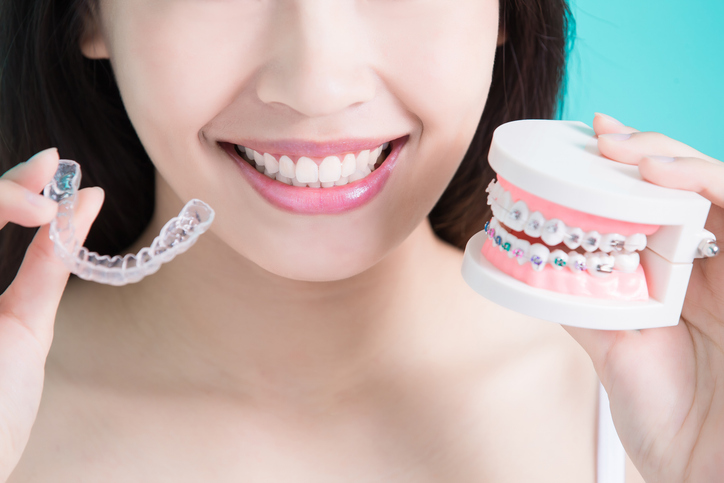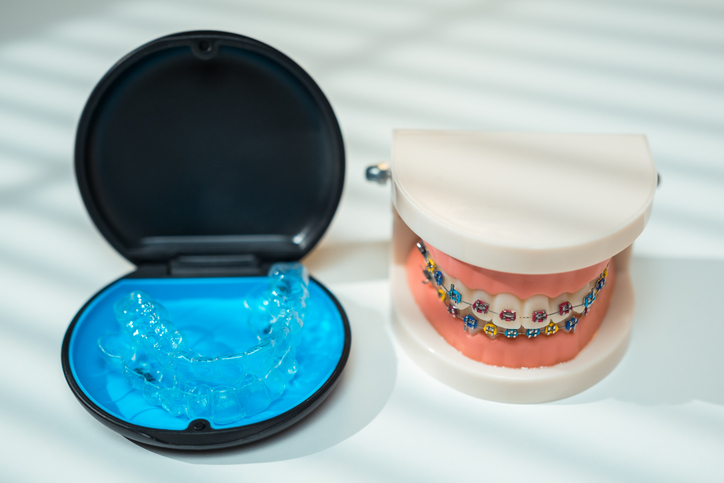
A straight, healthy smile is more than just a confidence booster—it plays a crucial role in your oral health. If you have misaligned teeth, gaps, or bite issues, orthodontic treatment can help correct these problems, improving both aesthetics and function. Two of the most popular options for orthodontic treatment are Invisalign and traditional braces.
Each of these treatments has its own unique benefits, and choosing the right one depends on factors such as your lifestyle, the complexity of your case, and your commitment to treatment. Let’s explore the differences between Invisalign and traditional braces so you can make an informed decision about the best option for your smile.
How Invisalign and Traditional Braces Work
Both Invisalign and traditional braces are designed to gradually move teeth into their ideal position, but they work in different ways.
Invisalign: The Clear Alternative to Braces
Invisalign uses a series of clear, custom-made aligners that fit snugly over your teeth. These aligners are made of smooth plastic and are virtually invisible when worn.
The Invisalign Process:
- Consultation: An orthodontist evaluates your teeth and creates a customized treatment plan using digital scans.
- Custom Aligners: You receive a series of aligners, each designed to make slight adjustments to your teeth.
- Wearing the Aligners: Aligners must be worn 22 hours a day and switched out every one to two weeks to continue progress.
- Final Adjustments: Once your treatment is complete, a retainer is used to maintain results.
Traditional Braces: The Time-Tested Approach
Traditional braces use metal or ceramic brackets that are bonded to the teeth, with wires and rubber bands that apply gentle pressure to shift teeth into place.
The Braces Process:
- Placement: Brackets are attached to the teeth, and an archwire is threaded through them.
- Adjustments: Every few weeks, the wire is tightened to continue moving the teeth into proper alignment.
- Completion: Once teeth are correctly positioned, the braces are removed, and a retainer is provided to maintain results.
Both treatment options are effective, but the right choice depends on your needs and preferences.
Key Differences Between Invisalign and Traditional Braces
1. Appearance
- Invisalign: Clear aligners are nearly invisible, making them a discreet choice.
- Braces: Traditional metal braces are more noticeable, though ceramic options blend in with teeth.
2. Comfort & Convenience
- Invisalign: The aligners are smooth and removable, which means no metal wires or brackets causing irritation.
- Braces: Brackets and wires can sometimes cause discomfort, especially after adjustments.
3. Effectiveness for Different Cases
- Invisalign: Works well for mild to moderate misalignment but may not be ideal for severe bite issues.
- Braces: More effective for complex cases, including significant overcrowding, overbites, underbites, and crossbites.
4. Treatment Duration
- Invisalign: Treatment time varies but typically lasts 12 to 18 months, depending on patient compliance.
- Braces: Can take 18 months to 3 years, depending on the complexity of the case.
5. Eating and Drinking Restrictions
- Invisalign: Aligners must be removed before eating or drinking anything other than water.
- Braces: Some foods, like sticky or hard foods, should be avoided to prevent damage.
6. Oral Hygiene & Maintenance
- Invisalign: Easy to maintain because aligners can be removed for brushing and flossing.
- Braces: Requires extra care when cleaning around brackets and wires, and flossing may be more challenging.
Both options have advantages, and the best choice depends on your dental needs and lifestyle.
Who Is a Good Candidate for Each Treatment?
Not everyone is a candidate for both Invisalign and braces. Your orthodontist will assess your teeth and recommend the most effective option for you.
Best for Invisalign:
✔️ Mild to moderate misalignment (such as minor spacing or crowding)
✔️ Adults and teens who can commit to wearing aligners for 22 hours a day
✔️ Patients who prefer a discreet treatment option
Best for Traditional Braces:
✔️ More complex dental issues (such as severe crowding, bite misalignment, or rotated teeth)
✔️ Children and teens who may struggle to keep track of aligners
✔️ Patients who don’t want to worry about removing and replacing aligners throughout the day
Your orthodontist will consider factors like your age, dental history, and personal preferences before making a recommendation.
Making the Right Choice
Choosing between Invisalign and traditional braces is a personal decision that depends on your goals, lifestyle, and orthodontic needs. Invisalign offers a nearly invisible, comfortable alternative for those with mild to moderate misalignment, while traditional braces are a time-tested solution for more complex cases.
The best way to determine the right option for you is to schedule a consultation with our team at Thai Orthodontics. Dr. Lauren and Dr. Dean are here to guide you through the decision-making process and create a personalized treatment plan tailored to your needs.
Ready to take the first step toward a healthier, more confident smile? Contact us today to schedule your consultation!

